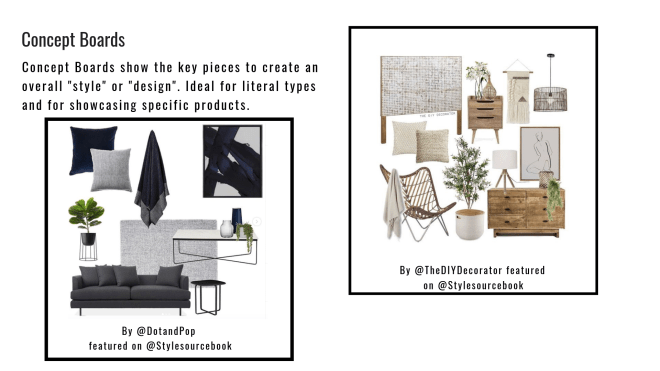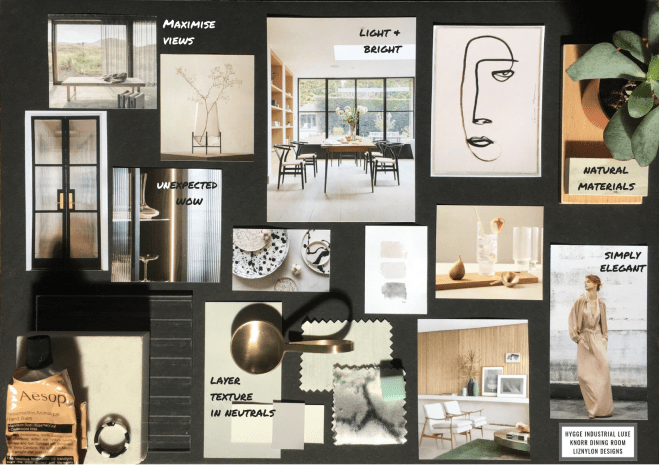Who else gets excited when they see or think about Mood Boards? Anyone? anyone? I’m not afraid to say its one of my fave things. Perhaps it’s the anticipation of something new – or – the fun of thinking about all the possibilities for a project & space – or – being a geek and seeing what other people are up to. For decades, I’ve been whipping up Mood Boards for myself and for work. Yup, there was a wedding Mood Board, a first birthday party Mood Board, the en-suite Mood Board, the work portfolio Mood Board, and endless client Mood Boards. Let’s just say Mood Boards have been good to me.

Now, I’m going to geek out a bit, so please stick with me! I guess what I love most about Mood Boards is the diversity and the flexibility. It can range from something abstract to inspire or something extremely literal to illustrate a design direction. So I thought I’d first share some “Inspiration” so you can think about how you can use “Boards” too.
Let’s start with Colour Boards, a great way to explore potential colour palettes for a design. The Queen of colour, Sophie Robinson , runs Colour Workshops, has an interior design online course, has a thriving interior design business and of can be found on your telly. There is also the brilliant Pattern Curator which is fab Inspo for exploring colour ranges and pattern plays. Design Seeds has worked with some of the biggest brands and takes a simple image & breaks the colours into a simple colour palette.

The oh so moody Mood Boards, an endless source of inspiration. See below Gudy Herder of Eclectic Trends and MoodBoard Academy who runs a Masterclass in Mood Board and is a go to for Trends. I found Anthos Design Studio creatively random photos approach inspiring and Room Service Creative luxuriously abstract design intriguing.

Concept Boards are a simple and effective way to illustrate key pieces of a room design without laying it out in Sketch-Up, InDesign, Photoshop or AutoCAD. StyleSourceBook is an online tool to create mood boards and these by Dot and Pop Interiors and The DIY Decorator jumped out to me as ‘best in class’ examples. Simple, clean and easy to imagine what the finished room will look like.

Okay, I’m going to say it, the oh so sexy Sample Boards are full on tactile overload. A secret weapon of Interior Designers and a critical part of the final design presentation. Sample Boards are all the materials and textures that will be used in the final design from wallpaper to paint to flooring to curtains to cabinets to handles to accents. See below Andrew Jonathan Design‘s and Alison Giese’s lust worthy boards.

So with all these different types of “Boards”, how does one get started and what exactly should be included? The most important thing to remember is that Mood Boards aren’t just a collection of pretty photos, each item you select must help to tell the story.
So what to include in the Mood Board? I thought I’d pull together a check list to help guide myself and others when creating their own Mood Boards. I’m no expert and there are classes you can attend (Eclectic Trends and Sophie Robinson) and endless tools you can use (Canva, Style Source Book, Milanote, etc). Over the years, I’ve found there tends to be five key elements to include in a Mood Board – now these are just my thoughts and what I’ve found useful over the years.
Let’s jump in, starting with the most important item, “The Hero Image“. Let’s be honest, it is the STAR of the entire Mood Board. It screams “Yes, I want you. I need you. I must have you”. It is the essence of what you’d love to achieve. Here are a few images that I considered as the “Hero” of my current Mood Board.
The Colour Palette from vibrantly colourful to naturally neutral, include your key colours in larger sizes and the secondary colours (aka accent colours) considerably smaller. Similar to the ratio you are thinking for the space. My current board are all about the nudes and greys, these are a few images I considered for my Mood Board.
Lifestyle is critical. We all associate feelings and emotions with the expected lifestyle the space will provide. I use travel, fashion, restaurants, museums, art, city streets, nature as potential lifestyle images. A mix of imagery with objects and people. The images I selected convey elegance, an indoor-outdoor lifestyle, entertaining yet a cool calm vibe with a touch of urban.
Adding a 3-D component to Mood Boards makes them more realistic and life like. This is where design details play a key role. This could be a repeat pattern, an abstract floral, a textured glass, or metal accents. It could be flowers, plants, yarn, twigs, ceramics, a train ticket. This is where you would express that idea using a product sample or any object. Remember it must convey the overall mood/vibe of the space and the colour palette. The images I selected included narrow wood slats, fluid line art and abstract splats and product samples plus a brass spoon.
Lastly, words words words words. (imagine the song playing in the background) Keep it simple and brief. 4-5 words max that describe the overall idea and key aspects of the design. These should be placed around imagery that convey that idea. You can also add a Mood Board Title or Theme. Here are some of the words I considered for my Mood Board.
Ta Da. Here is the current Mood Board I’m working on. I’ve called it “Hygge Industrial Luxe” and you can see how I’ve brought together each of the five Mood Board ‘Must Haves’ : Hero Image + Colours + Design Details + Lifestyle Images + Words.

So, where to start …
Pinterest is your best friend
It is all about knowing what words to use when searching so mix it up. Search wide and broad. Change your search words to see how the images differ. It’s best to do more than less. Create a new board for all the images. In the above Mood Board, I started with 100 images.
Go on, get out in the REAL world
It’s time to say bye bye to Pinterest, step away from your laptop and get out in the real world, go explore, take photos, collect items, collect words and consider textures. Hit cafes, art galleries, wander, get lost, sit in the park, head to the beach or mountains, go to events, ride the bus, hit bookstores, fashion boutiques, anywhere and everywhere. Main thing is keep your eyes open.
Time to EDIT
Just like Love Island, you must pick an image and answer the difficult questions “I’ve chosen this image because it …” I’ve found it most helpful to print all the images and spread them out on a table. I group the images into themes and then for each theme, I select the strongest images/objects. I then start to build the Mood Board, swapping images in/out to see how it changes the overall vibe.
Layout is everything
There are some serious cool tools out there from Canva to Unfold that are free, more corporate/office based tools like Keynote to Powerpoint and more technical like InDesign and Photoshop. While searching this, I found a new tool StyleSourceBook that I want to try out.
The layout and design also helps to conveys your idea — collage layout, structured minimalist layout, artsy playful layout. This also goes for the font you use for the words from script to marker to bubbly to clean & thin. So, my best advice is try out different layouts.
Get critical. Judge it. Ask for feedback.
I don’t know about you, but I never get it right on the first go around. Step away from the Mood Board, take a break, ask others for feedback. I’ve pulled together a few questions to help you decide if your Mood Board is on point.

That’s a wrap on Marvellous Masterful Mood Boards. I hope you’ve found this helpful. I’ve created a Pinterest Board on the various Colour Boards, Concept Boards, Mood Boards and Sample Boards that I find inspiring. Go on have a nosy, click HERE. Also, DM me if you have a Board that you want me to include.
Are there other things that you include in your Mood Boards? Are there different tools that you use to create Mood Boards? I’d love to hear from you. Let me know by leaving a comment below. Any questions? Comments? Thoughts? Have a board that you love? Share it with me and I’ll put it up in Pinterest Board and I’ll also do a round up in Insta stories.
As always, these are my own opinions. Thank you for reading!
Cheers,
Liz xx













One Comment